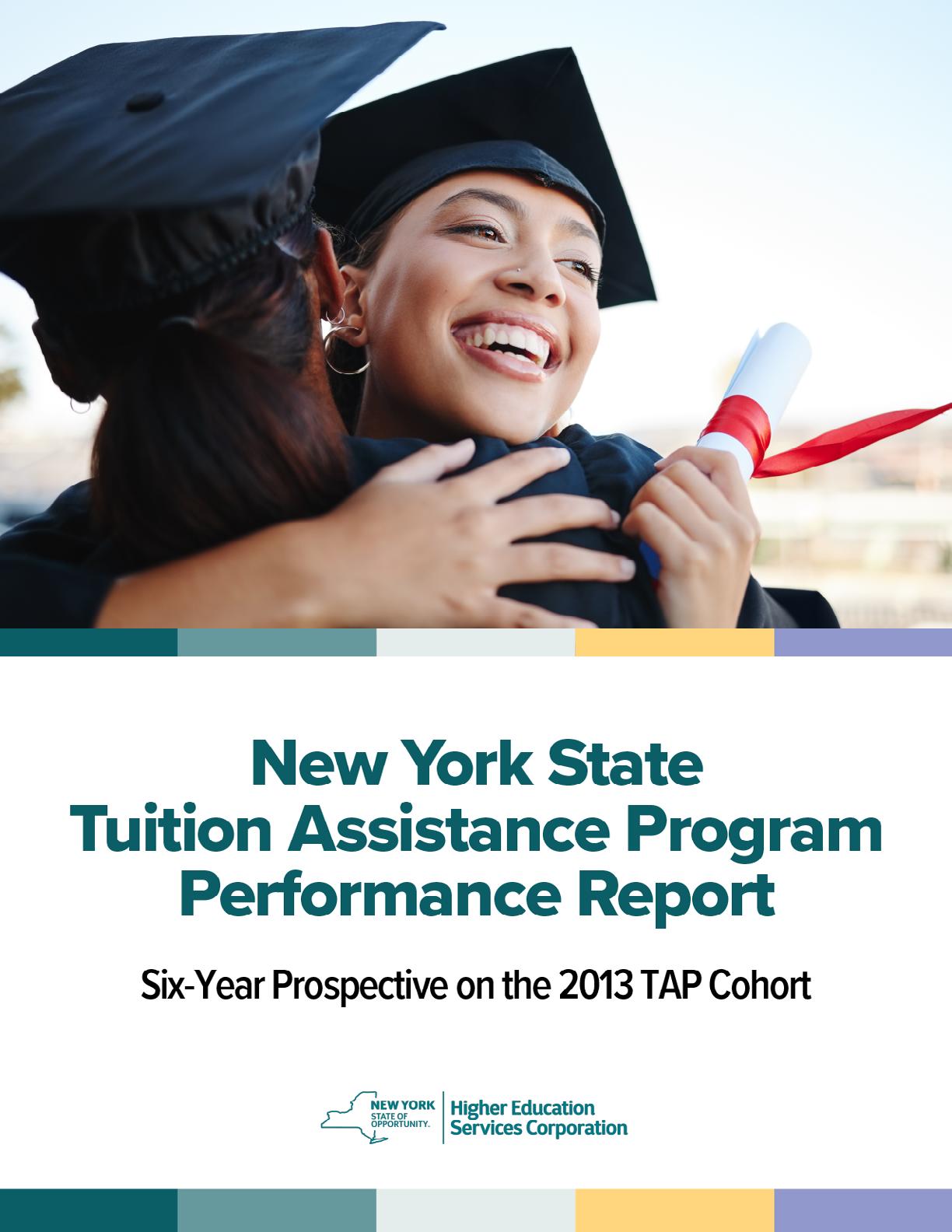

About this Report
The New York State (NYS) Tuition Assistance Program (TAP), first implemented in 1974, has consistently provided thousands of New Yorkers with aid and is one of the nation’s largest needbased college financial aid grant programs. In the 2022-2023 academic year, TAP provided
more than $662 million in student aid to 234,000 students across the state. This report examines six-year undergraduate student completion rates among first-time recipients of TAP who started their postsecondary education in a NYS college or university in the fall of 2013.
This report seeks to address the following:
Are more TAP recipients graduating than not graduating in six years?
Is more TAP funding spent on those who graduate than those who do not graduate in six years?
Key Findings
• The six-year completion rate among first-time TAP recipients is 59%, and four in five of these graduates earned a Bachelor’s degree in six years.
• TAP expenditures for six-year graduates, at $353 million, were approximately three times more than the $133 million spent for students who did not graduate in six years.
• Independent and SUNY 4-Year colleges had the highest six-year completion rates, at 81% and 80% respectively, while SUNY 2-Year colleges had the lowest rate at 31%.
• TAP spending during the six-year period was highest for students starting their postsecondary education at Independent ($124 million), SUNY
What are the trends in completion rates and TAP expenditures, by sector?
How do completion rates in transfer students compare to that in non-transfer students?
4-Year ($113 million), and CUNY 4-Year colleges ($106 million); most of the TAP funding was spent on students who graduated, 83%, 82% and 69%, respectively.
• TAP spending during the six-year period was lowest for those starting their postsecondary education at a Proprietary college, at nearly $12 million, and 65% of the TAP funding benefited students who graduated.
• The six-year completion rate among transfer students was 51% and among non-transfer students was 63%; the six-year completion rate was highest among those transferring from a two-year to a four-year institution at 64%.
Methodology
The 2013 TAP cohort included students ages 19 and under who attended college directly after graduating from high school and received TAP for the first time.
TAP recipient age, income, and award information were gathered from TAP application data. TAP recipients were matched to the Free Application for Federal Student Aid, or FAFSA, data (i.e., the Institutional Student Information Record, or ISIR) to identify first-time college students. Enrollment and graduation records were obtained from the National Student Clearinghouse (NSC).
Records where the first enrollment in college was prior to TAP receipt in the fall of 2013 and the enrollment status was ‘Less than half time’ were considered pre-college or high school college courses and were excluded. The cohort was limited to students with undergraduate records.

Completion was considered receipt of a Bachelor’s or Associate degree by June 30, 2019, the end of the six-year period. Degree attainment assessed the highest undergraduate degree earned (Bachelor’s or Associate) by June 30, 2019. Stop-out referred to failing to graduate in six years where final college enrollment in the six-year period was prior to July 1, 2018. Certificate earners and students who graduated in unusually short time periods (i.e., attained a Bachelor’s degree in less than two years) were excluded from analyses.
Transfer status was determined by comparing the starting school to the ending school, that is, the institution that conferred the student’s highest undergraduate degree or the final school students were enrolled at during the six-year period.
TAP Eligibility Requirements:
• Be a legal resident of NYS and have resided in NYS for 12 continuous months
• Be a U.S. citizen or eligible non-citizen
• Have graduated from high school in the United States, earned a high school equivalency diploma by passing a Test Assessing Secondary Completion (TASC) formally known as a GED, or passed a federally approved “Ability to Benefit” test
• Be matriculated in an approved program of study and be in good academic standing with at least a “C” average after the fourth semester payment
• Be enrolled as a full-time student taking 12 or more credits applicable toward the degree program, per semester
• Have a household net taxable income below $80,000
Tuition Assistance Program Overview
The TAP grant covers up to four years of full-time undergraduate study or five years in an approved program. TAP award estimates are based on New York State net taxable income. To be eligible for TAP, a student's household net taxable income must be less than $80,000. However, students in the same income bracket may still receive different amounts of financial aid (i.e., be on different award schedules) due to a variety of factors that are
considered in calculating a student's award, such as their dependency status and number of siblings in college. As household net taxable income declines, the maximum TAP award availability increases, as shown below. In 2013, TAP awarded eligible New York residents between $500 to $5,165 per year towards tuition at approved postsecondary institutions in New York State.
NYS Net Taxable Income
$70,001 to $80,000
Maximum TAP Award Available AY2000-01 to AY2020-21
Maximum TAP Award Available Currently* (AY2022-23)
$30,001 to $40,000
$20,001 to $30,000
$10,001 to $20,000

The 2022-2023 Budget expanded Part-Time TAP by eliminating the full-time enrollment requirement. Part-Time TAP became available to more students and included support to part-time students in non-degree training programs. In addition, TAP availability to incarcerated individuals was restored.
Cohort Description
2013 TAP Cohort by the Numbers

58,677
Total TAP disbursed over the 6-year period
Largest ending sector: SUNY 4-Year
The TAP 2013 cohort analyzed in this report consisted of 58,677 first-time TAP recipients who entered college directly after graduating from high school or obtaining their high school equivalency in 2013. Age at time of entering college ranged from 13 –19, with the majority of students (53%) at age 18 (Fig. 1). Most students (39%) had household net taxable incomes of $10,000 or less, while just 5% had annual incomes of $70,001 –$80,000 (Fig. 2).
Over the six-year period, the total TAP expenditures were $485,779,095, with each recipient on average receiving $8,279 over six years. Most recipients (45%) received a total of up to $5,000, while just 7%, the neediest of individuals, received more than $20,000 (Fig. 3). The average annual TAP award per recipient was $2,957.
Fall 2013–June 30, 2019
Enrollment Patterns
SUNY 2-Year and Independent colleges had the most students enrolled at entry into college, 29% and 22% of the cohort, respectively. Proprietary, or for-profit, schools had the lowest share of students at 2%. A student’s ending sector was the sector of the college where they graduated or ended their college enrollment within the six-year period. By June 30, 2019, more students had graduated or
ended their college enrollment at CUNY and SUNY 4-Year colleges than had started college at these sectors, an indication of upward transfers from a two-year to public four-year institution. While all TAP recipients began higher education in a NYS college, by the end of the six years, 4% transferred to out-ofstate schools (Fig. 4).
(N=19)
While students could have transferred multiple times during the six-year period, this report compared the starting school to the ending school to determine if a transfer occurred. Sixty-nine percent of TAP recipients did not transfer over the six-year period. Fourteen percent of TAP recipients laterally transferred between two-year schools or between four-year schools, while 12% of the cohort transferred upward from a two-year/less than two-year to a four-year school. Reverse transfers, those who went from a four-year school to a twoyear school, accounted for 5% of the cohort. The remaining <1% of the cohort transferred from a twoor four-year school to a less than two-year school (degree to non-degree transfer).
Six-Year Student Completion
59%
Graduated in 6 Years 49% Of grads completed school on time* 66% Of non-grads dropped out prior to the 6th year
4.3
Average number of years to graduate among Bachelor's earners
Fifty-nine percent of TAP recipients graduated within six years, and among these graduates, 49% obtained their degree on time (Fig. 6).
2.1
Average number of years to stop out
Approximately 81% of six-year graduates earned a Bachelor’s degree. Among the Bachelor’s earners, 55% obtained their degree in four years (on time). Whereas, among those whose highest undergraduate degree was an Associate, 20% graduated on time (i.e., in two years) (Fig. 7).
*On-time: Among those whose highest undergraduate degree was an Associate, they graduated in 2 years. Among those whose highest undergraduate degree was a Bachelor’s, they graduated in 4 years.
Institutional Trends in Six-Year Completion Rates
Independent and SUNY 4-Year schools saw the highest six-year completion rates, conferring undergraduate degrees to 81% and 80% of students, respectively, who either graduated from or ended their college pursuits at these schools (Fig. 8).
8. Six-Year Completion Rates by Ending Sector
CUNY and SUNY 2-Year colleges saw the lowest completion rates at 32% and 31%, comparable to students who graduated from or ended their college pursuits at an out-of-state school (33%).
TAP Spending
A total of $485,779,095 in TAP awards was disbursed over the six-year period. Most ($353 million, or 73%) of the TAP funding was spent on students who ended up graduating by June 30, 2019. Total spending on graduates nearly tripled

spending on non-graduates. Approximately $306 million, or 63% percent of the total TAP funding, supported Bachelor’s degree earners, while nearly $47 million, just 10%, supported Associate degree earners (Fig. 9).
Figure 9. Distribution of TAP Spending:
Institutional Trends in TAP Spending
The largest amount of TAP spending was disbursed to students starting at an Independent school, at 26% of the total TAP spending. SUNY and CUNY 4-Year schools followed, with 23% and 22% of total TAP spending, respectively. TAP disbursement was lowest (2%) for students starting at Proprietary schools (Fig. 10). TAP funding for students starting at Independent and SUNY 4-Year colleges was more likely to be spent on graduates, with 83% and 82% of spending benefiting students who eventually graduated with a Bachelor’s or Associate degree
by June 30, 2019. While CUNY 4-Year colleges as a starting sector received 22% of total TAP spending, comparable to SUNY 4-Year colleges, 69% of that TAP disbursement benefited students who eventually graduated. While TAP disbursement was low at Proprietary colleges as a starting sector, 65% of that TAP disbursement benefited future graduates. Compared to the other starting sectors, SUNY 2-Year colleges had the lowest percent of TAP funding (58%) benefiting future graduates (Fig. 11).
Transfer Students
Students whose ending school differed from their starting school (indicative of a transfer during the six-year period) graduated at a lower rate than those who did not transfer, at 51% and 63% respectively (Fig. 12). Students who transferred upward to a fouryear, from a two-year/less than two-year school to a four-year institution, had the highest completion rates (64%), even slightly better than non-transfers
(63%) (Fig. 13). Among those who transferred and graduated with a Bachelor’s, the average time spent in school was 4.7 years compared to 4.1 among non-transfers. Those who transferred and stopped out spent an average of 3.3 years in school before stopping out, while non-transfers who stopped out spent an average of 1.8 years in school.

The six-year total TAP disbursement on transfer students was $154 million, which is approximately half the total TAP spending ($332 million) on nontransfer students. Among transfer students, most of the TAP spending ($73 million, or 48%) was spent on students with lateral transfer while just $48,000 (<1%) was spent on students with degree to nondegree transfer. Upward transfers, with the highest completion rates, received the second largest share of TAP funding ($63 million, or 41%) (Fig. 14).
Conclusion
Having a college degree typically means having greater earning potential, increasing future tax revenue and boosting the economy.1 However, for low-income students, a college degree may seem unattainable, as studies have shown that low-income students have lower rates of college success than high-income students.2 The NYS Tuition Assistance Program aims to mitigate the educational barrier of cost for low-income students.
This report found that the six-year completion rate among first-time TAP recipients who started college in academic year 2013-2014 was 59%, which was comparable to that nationwide (60.7%), according to the 2022 National Student Clearinghouse Completing College Report 3 Moreover, four in five of the graduates who received TAP funding were Bachelor’s earners. TAP expenditures were also shown to be three times more likely to benefit students who ended up attaining a Bachelor’s or Associate degree. Taken together, these findings show that more TAP recipients graduated in six years than not, though improvements in completion rates are needed. As well, far more TAP funding was spent on those who ended up graduating in six years than not.
Completion rates in the 2013 TAP cohort varied by sector. Independent and SUNY 4-Year ending sectors saw the highest six-year completion rates, at 81% and 80% respectively, which were well above the nationwide rate of 60.7% across all sectors. In contrast, six-year completion rates at CUNY and SUNY 2-Year ending sectors were the lowest, at 32% and 31%, respectively. These rates were comparable to that among students who either graduated from or ended their college pursuits at an out-of-state college (33%). Low completion rates at public community colleges might be in part due to challenging life circumstances often associated with low socioeconomic status.4 Because this report defined degree attainment as the highest undergraduate degree, students who transferred from a two-year to a four-year college where they earned a Bachelor’s were not represented in the CUNY 2-Year and SUNY 2-Year ending sector completion rates. To better understand this population, this report analyzed transfer students (Fig. 15).
1 Georgetown University Center’s 2021 report, The College Payoff, showed that workers with Bachelor’s degrees earned 75% more ($1.2 million more median lifetime earnings) than those with only a high school diploma/GED.
2 The 2022 Pell Institute Equity Indicators Report, for example, showed that Bachelor’s degree attainment by age 24 among the highest income quartile was nearly 4 times that among the lowest income quartile, and 2.5 times that among the second lowest income quartile.
3 While this report excludes certificate earners, the NSC nationwide figures include them. If certificate earners were included (N=364) in the 2013 TAP cohort, the six-year completion rate would increase to 60%.
4 The Hechinger Report, in a 2023 article titled “The Reckoning is Here,” detailed Amarillo College’s profile of a typical community college student: “Maria: first-generation, part-time and Hispanic, and a mother of 1.2 children who is 27 and works two part-time jobs.”
Transfer students are known to be a vulnerable subgroup of college-goers; they have been shown not only to be mostly low-income but also to have lower rates of degree attainment.5 Nearly one-third of this TAP cohort were transfer students. Transfer students have been found to face challenges in attaining a degree due to difficulties in transferring credits, lack of early momentum due to a slower pace of learning at community colleges, and unclear transfer pathways, among other barriers.6 Despite such odds, TAP recipients who were also
5 According to the 2016 Community College Research Center Tracking Transfers Report, just 14% of students who start higher education at community college earn a bachelor’s degree within six years.
upward transfer students had the highest six-year completion rates among the 2013 TAP cohort at 64%, nearly four percentage points higher than the nationwide rate of 60.7%. The most common transfer pathways among upward transfers were from SUNY 2-Year to SUNY 4-Year (39%), CUNY 2-Year to CUNY 4-Year (22%), and SUNY 2-Year to Independent (15%). The successful student outcomes may attest to a smooth transfer process and continuity of financial aid within the SUNY and CUNY systems (Fig. 15).
6 The Center for Analysis of Postsecondary Education and Employment 2016 working paper explores an additional barrier of transfer shock, where upward transfer students are unprepared for the academic rigor of the four-year college and eventually drop out.
Success Stories

81% and 80%
6-year completion rates were almost 20 percentage points higher than the overall nationwide rate of 60.7% 83% and 82% of 6-year TAP spending at these starting sectors benefited 6-year graduates, the highest percent among all sectors
6-year completion rate was nearly 4 percentage points higher than the overall nationwide rate of 60.7%
Most common transfer pathways were SUNY 2-Year to SUNY 4-Year (39%), CUNY 2-Year to CUNY 4-Year (22%), SUNY 2-Year to Independent (15%)
Limitations

Coverage
Approximately 6% of the TAP students submitted to the NSC did not have any college record found in the NSC. This can be due to NSC limitations in data coverage as some students opt out of participating in NSC reporting and some colleges do not submit information to the NSC, including many Chapter XXII institutions—this sector on average accounts for 4% of total TAP spending annually for students under age 22. The 2013 cohort therefore may not include all first-time TAP recipients aged 19 and under entering college for the first time in academic year 2013-2014.
Completion Rates
Certificate earners were excluded from the analysis; therefore, this report may underestimate completion rates. Public two-year ending sector completion
rates do not reflect students who earned both an Associate and a Bachelor’s, as they were included in the four-year institution completion rate to avoid categorizing the students in multiple sectors. Transfer status was determined by comparing the starting school to the school that conferred the student’s highest undergraduate degree or the final school students were enrolled at during the six-year period. While students may have transferred to other schools during the six years, this information was not captured in transfer analyses.
References
Cahalan, Margaret W., Addison, Marisha, Brunt, Nicole, Patel, Pooja R., Vaughan III, Terry, Genao, Alysia & Perna, Laura W. (2022). Indicators of Higher Education Equity in the United States: 2022 Historical Trend Report. Washington, DC: The Pell Institute for the Study of Opportunity in Higher Education, Council for Opportunity in Education (COE), and Alliance for Higher Education and Democracy of the University of Pennsylvania (PennAHEAD). Carnevale, A.P., Cheah, B., Wenzinger, E. (2021). The College Payoff: More Education Doesn’t Always Mean More Earnings. Washington, DC: Georgetown University Center on Education and the Workforce.
Causey, J., Lee, S., Ryu, M., Scheetz, A., & Shapiro, D. (2022). Completing College: National and State Report with Longitudinal Data Dashboard on Six- and Eight-Year Completion Rate. (Signature Report 21). Herndon, VA: National Student Clearinghouse Research Center. Jenkins, D., & Fink, J. (2016). Tracking Transfer: New measures of institutional and state effectiveness in helping community college students attain bachelor’s degrees. New York, NY: Community College Research Center.
Marcus, J. (2023, May 8). ‘The reckoning is here’: More than a third of community college students have vanished. The Hechinger Report. https://hechingerreport.org/the-reckoning-is-here-morethan-a-third-of-community-college-students-have-vanished/ Xu, D., Smith Jaggers, S., Fletcher, J. (2016). How and Why Does Two-Year College Entry Influence Baccalaureate Aspirants’ Academic and Labor Market Outcomes: A CAPSEE Working Paper. Center for Analysis of Postsecondary Education and Employment.





